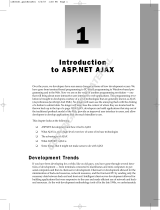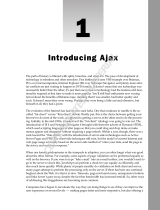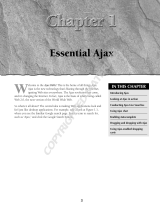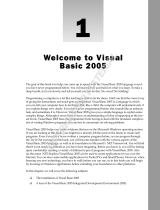Page is loading ...

Part I: Grids, Editors,
Navigation, and Controls
Chapter 1: Programming with the ASPxGridView
Chapter 2: Advanced ASPxGridView Computing
Chapter 3: Using the ASPxTreeList, ASPxDataView, and
ASPxNewsControl
Chapter 4: Adding SiteMaps, Navigation, and Popup Dialog Boxes
Chapter 5 : Implementing a Menu and Tabbed Controls
Chapter 6: Managing Scheduled Items and Using Gauges
c01.indd 1c01.indd 1 10/8/09 3:54:18 PM10/8/09 3:54:18 PM
COPYRIGHTED MATERIAL

c01.indd 2c01.indd 2 10/8/09 3:54:20 PM10/8/09 3:54:20 PM

Programming with the
ASPxGridView
This year is the tenth anniversary of my VB Today column for Codeguru.com and Developer.com.
(My first article was published in PC World in 1992.) In that time, during which I ’ ve written
hundreds of articles, readers have written to me more about two subjects than any other: keyboard
hooking and grid controls.
Low - level keyboard hooks are cool. I started using them with DOS interrupts and C++ in the early
1990s. Grids of data, however, have the more practical and compelling everyday usefulness.
For years now, customers have asked me to make grids do things that they originally did not seem
designed to do, including doing complex relationship modeling with grid nesting and performing
real - time calculations with solutions that are more like Rube Goldberg machines than algorithms.
Although crafting these solutions — sometimes against my better judgment — with nested user
controls and hand - written asynchronous callbacks from scratch has been fun, I ’ m pleased to pass
the baton off to the
ASPxGridView .
The
ASPxGridView is designed to support nesting, the power of Ajax callbacks, tuned
performance for small and huge data sets, sorting, grouping, creating summaries, working with
themes and skins, and much more. This chapter and the next chapter explore the
ASPxGridView .
I created the TotalFlight database for the samples used in these chapters because I wanted large
amounts of data, but you can easily use Northwind or any other database that has a great deal of
data to run the samples. (I used Red Gate Software ’ s SQL Data Generator 1 to populate the
TotalFlight database.)
c01.indd 3c01.indd 3 10/8/09 3:54:20 PM10/8/09 3:54:20 PM

Part I: Grids, Editors, Navigation, and Controls
4
Understanding How Ajax Delivers Real
Performance to the ASPxGridView
A lot of conventional wisdom floats around, including the idea that to get high performance from your
Web applications, you need to limit the amount of data you return to the client. Generally, limiting
returned data required that each programmer limit possible query results or invent some mechanism for
micromanaging high - data - prone controls such as grids. Then, things changed — and they seemed to
change pretty quickly even for Internet time. Ajax had arrived.
Now called Ajax (in mixed case), the term AJAX (all uppercase) was coined in 2005. Originally, AJAX
was an acronym for Asynchronous JavaScript and XML. AJAX was a derivative of capabilities created in
the 1990s, including Internet Explorer ’ s IFrame and Java Applets, and is based on the ActiveX object
XMLHttpRequest, or remote scripting for browsers that don ’ t support XMLHttpRequest . The term
AJAX brought asynchronous callbacks to the general programming community ’ s attention, and AJAX
made controls such as the
UpdatePanel accessible to all developers. (These later developments actually
happened in 2005 and 2006.) Originally dubbed AJAX for JavaScript, XML, or asynchronous calls, it is
now simply referred to as Ajax.
What Does Ajax Do for Web Developers?
Web forms have a life cycle. (Refer to “ Appendix A: Understanding How Web Applications Differ from
Windows Applications ” for more on page life cycles.) When a page is posted back from the client to the
server, it goes through the entire life cycle. This life cycle includes rerendering the page, which in turn
causes the very visible page flicker users experience. Many times, much of what the user experiences is
the result of static content and minor changes based on their interactions with the page; what they pay
for with a postback is the re - creation of everything.
Ajax uses callbacks. A callback sends data back to the server, but only the relevant response is returned
through the browser. Ajax plumbing literally used to require — as late as 2005 — programmers to inject
dynamic JavaScript, wire up event handlers, and manually parse and stuff text returned into the client
Web page with more JavaScript. (There are dozens of JavaScript examples throughout the book.) The
benefit of employing all this specialized knowledge is that users had a better experience because they
paid for data refreshes only when something actually changed on a page. Also, pages seemed to update
magically.
You can still use wired - up Ajax with injected script if you want, but it is more error prone and requires
great JavaScript authoring and debugging skills. With DevExpress controls and the
ASPxGridView,
you get the benefit of Ajax without the hassle.
ASPxGridView and Ajax
On top of all the features in the ASPxGridView , including sorting, grouping, filtering, and summaries,
the
ASPxGridView does three very important things that help you get the highest performance: It uses
the database server instead of client - side script to manage data; it manages the client
VIEWSTATE block
c01.indd 4c01.indd 4 10/8/09 3:54:22 PM10/8/09 3:54:22 PM

Chapter 1: Programming with the ASPxGridView
5
To demonstrate the ASPxGridView, you can follow the examples in this chapter and the next to build
the TotalFlight sample shown in Figure 1 - 1, which includes a 1,000,000 - row result set.
Figure 1 - 1: You can complete the TotalFlight passenger manifest sample by
working through the samples in this chapter and in Chapter 2.
Microsoft shipped the UpdatePanel in late 2005 (or 2006). Any control can get some
Ajax support with the
UpdatePanel.
itself by using a smart caching engine rather than sending tons of VIEWSTATE to the client; and it is built
using Ajax internally. The
UpdatePanel is supported — by setting EnableCallbacks to false — but
the
UpdatePanel is not required.
Another feature of the
ASPxGridView is the EnableCallbackCompression property. IIS supports
compression — a general approach — whereas the
ASPxGridView will support compression for the grid
if IIS compression is not enabled, a refinement from the general in IIS to the specific compression in the
ASPxGridView . (Refer to the Appendix A section “ Upgrading to IIS 7 ” for information on enabling IIS
compression.) If you set
ASPxGridView.EnableCallbackCompression to true, the grid checks to see
whether the
Accept - Encoding request header contains gzip or deflate — if content encoding is
supported by the browser — and
ASPxCallback compresses the result if supported. You can check the
Accept - Encoding value by using a free tool such as Fiddler (see Figure 1 - 2) or exploring the
Page.Request.ServerVariables[ “ HTTP_ACCEPT_ENCODING ” ] value in Visual Studio debug mode.
c01.indd 5c01.indd 5 10/8/09 3:54:22 PM10/8/09 3:54:22 PM

Part I: Grids, Editors, Navigation, and Controls
6
Figure 1-2: The Accept-Encoding value shown in the free tool Fiddler available from
www.fiddler2.com/fiddler2/version.asp.
Binding and Editing Data in the
ASPxGridView
You can choose from among many ways to get data into an ASPxGridView . The easiest way is to use
declarative programming, add a data source, and associate it with the grid through the IDE. In this
section, you can walk through a few of the ways to get data into the grid to experiment with the
functionality of the
ASPxGridView . (Because persistent objects and the XpoDataSource is a DevExpress
product, it gets its own coverage in Chapter 7, “ Using the Data that Makes Sense for Your Problem. ” ) An
exploration of editing column definitions is also included in this section.
If you want to get started quickly, use Northwind or AdventureWorks. If you want a large quantity of
data, download the TotalFlight database from the Wrox code download site at
www.wrox.com.
Creating a New Data Source from the Task Menu
To create a new data source — assuming that you have added an ASPxGridView — right - click the
Tasks menu at the upper - right corner of the grid (see Figure 1 -3 ) and follow these steps:
1. Click the ASPxGridView ’ Tasks menu (see Figure 1 - 3).
2. Select Choose Data Source.
3. From the Choose Data Source drop - down list, select < New data source > to start the Data
Source Configuration Wizard.
c01.indd 6c01.indd 6 10/8/09 3:54:25 PM10/8/09 3:54:25 PM

Chapter 1: Programming with the ASPxGridView
7
4. From the Where Will the Application Get Data From? list, select Database. This selection adds
the default data source name
SqlDataSource1 .
5. Click OK.
6. In the Choose Your Data Connection, click the New Connection button.
7. In the Add Connection option, change the Data Source to Microsoft SQL Server (refer to
Figure 1 - 4).
8. For the sever name, enter .\SQLEXPRESS .
9. Leave authentication to Windows mode.
10. In the Connect to a database option, select the TotalFlight database.
11. In the Add Connection dialog box, click Test Connection. If the connection works, click OK.
12. Click Next.
13. Use the default name for the “ Save Your Connection String to the Application Configuration
File ” step. Click Next.
14. In the Configure the Select Statement, specify the PassengerManifest view.
15. For the Columns, select the * check box for a SELECT * query of the view.
16. Click Next.
17. Click the Test Query button.
18. Click Finish.
Figure 1-3: Click the tasks menu
(indicated here), click Choose Data
Source, and then click <New data
source> to start the Data Source
Configuration Wizard.
c01.indd 7c01.indd 7 10/8/09 3:54:28 PM10/8/09 3:54:28 PM

Part I: Grids, Editors, Navigation, and Controls
8
After you finish using the wizard, a SqlDataSource is added to the Web page containing the
ASPxGridView, the ASPxGridView ’ s DataSourceID property is set to the SqlDataSource1
component, and the grid is updated to reflect the columns in the
PassengerManifest view. If you look
at the Source view of the Web page, the ASPX should look like Listing 1 - 1.
Listing 1 - 1: The ASPX after running through the new data source configuration wizard.
< %@ Page Language=”C#” AutoEventWireup=”true” CodeFile=”Default.aspx.cs”
Inherits=”_Default”% >
< %@ Register assembly=”DevExpress.Web.ASPxGridView.v8.3, Version=8.3.2.0,
Culture=neutral, PublicKeyToken=b88d1754d700e49a”
namespace=”DevExpress.Web.ASPxGridView” tagprefix=”dxwgv” % >
< %@ Register assembly=”DevExpress.Web.ASPxEditors.v8.3, Version=8.3.2.0,
Culture=neutral, PublicKeyToken=b88d1754d700e49a”
namespace=”DevExpress.Web.ASPxEditors” tagprefix=”dxe” % >
< %@ Register assembly=”DevExpress.Xpo.v8.3, Version=8.3.2.0, Culture=neutral,
PublicKeyToken=b88d1754d700e49a” namespace=”DevExpress.Xpo” tagprefix=”dxxpo”
% >
< %@ Register assembly=”DevExpress.Web.ASPxGridView.v8.3, Version=8.3.4.0,
Figure 1-4: Configure the Add Connection dialog
box as shown to add a connection string for
TotalFlight to your web.config file.
c01.indd 8c01.indd 8 10/8/09 3:54:29 PM10/8/09 3:54:29 PM

Chapter 1: Programming with the ASPxGridView
9
Culture=neutral, PublicKeyToken=b88d1754d700e49a”
namespace=”DevExpress.Web.ASPxGridView” tagprefix=”dxwgv” % >
< %@ Register assembly=”DevExpress.Web.ASPxEditors.v8.3, Version=8.3.4.0,
Culture=neutral, PublicKeyToken=b88d1754d700e49a”
namespace=”DevExpress.Web.ASPxEditors” tagprefix=”dxe” % >
< !DOCTYPE html PUBLIC “-//W3C//DTD XHTML 1.0 Transitional//EN”
“http://www.w3.org/TR/xhtml1/DTD/xhtml1-transitional.dtd” >
< html xmlns=”http://www.w3.org/1999/xhtml” >
< head runat=”server” >
< title > < /title >
< /head >
< body >
< form id=”form1” runat=”server” >
< div >
< dxwgv:ASPxGridView ID=”ASPxGridView1” runat=”server”
AutoGenerateColumns=”False” DataSourceID=”SqlDataSource1” >
< Columns >
< dxwgv:GridViewDataTextColumn FieldName=”FlightNumber” VisibleIndex=”0” >
< /dxwgv:GridViewDataTextColumn >
< dxwgv:GridViewDataTextColumn FieldName=”LastName” VisibleIndex=”1” >
< /dxwgv:GridViewDataTextColumn >
< dxwgv:GridViewDataTextColumn FieldName=”FirstName” VisibleIndex=”2” >
< /dxwgv:GridViewDataTextColumn >
< dxwgv:GridViewDataTextColumn FieldName=”Title” VisibleIndex=”3” >
< /dxwgv:GridViewDataTextColumn >
< dxwgv:GridViewDataTextColumn FieldName=”Seat” VisibleIndex=”4” >
< /dxwgv:GridViewDataTextColumn >
<
/Columns >
< /dxwgv:ASPxGridView >
< asp:SqlDataSource ID=”SqlDataSource1” runat=”server”
ConnectionString=” < %$ ConnectionStrings:TotalFlightConnectionString
% > ”
SelectCommand=”SELECT * FROM [PassengerManifest]” > < /asp:SqlDataSource >
< /div >
< /form >
< /body >
< /html >
The top of Listing 1 - 1 are the Page and assembly registration statements. The ASPXGridView is defined
in the
< div > tag section with the DataSourceID and columns specified. Note the definition of the
SqlDataSource and the reference to the connection string and the select command. With the wizard
and the declarative style approach, you can get a page up and running without writing a single line of
ADO.NET code.
c01.indd 9c01.indd 9 10/8/09 3:54:31 PM10/8/09 3:54:31 PM

Part I: Grids, Editors, Navigation, and Controls
10
To test the demo, click Debug Start Debugging. The page will take several seconds to show up because
the database contains a million rows in the
PassengerManifest view. The page loads in about
20 seconds on my multiprocessor, 3GB, Windows Vista box running the Cassini server and SQLExpress
2005. These are pretty good results for everything running on a workstation; your results may vary but
should improve in a deployment environment. (See Figure 1 - 5.)
Figure 1-5: A million rows of data using the lightweight Cassini Web server, SQL
Express, all running on a Windows Vista workstation.
I am not advocating that you routinely have million - row result sets, because 20 seconds is a long time in
Internet time. (Anything more than a second is a long time in Internet time.) I am telling you that you
can return many rows in the
ASPxGridView if necessary, and the results will improve based on the
deployment infrastructure.
If you need to modify the data source, you can select Configure Data Source from the Tasks menu. If the
underlying schema changes, selecting Refresh Schema from the Tasks menu will update the columns in
the grid relative to the current schema.
The <%$ %> tag is called an ASP.NET expression. ASP.NET expressions are used
declaratively to set control properties at runtime based on connection strings,
application settings, and configuration and resource file information.
c01.indd 10c01.indd 10 10/8/09 3:54:32 PM10/8/09 3:54:32 PM

Chapter 1: Programming with the ASPxGridView
11
Figure 1-6: The columns Editor Form for managing column properties in the
ASPxGridView.
As a practical matter, begin building your applications with the amount and kind of information you
need. Don ’ t worry about matters such as speed too early on. You can always add hardware, tune, and
write data - limiting queries after some careful profiling. It is worth stipulating performance
characteristics in your requirements and keeping an eye on performance relative to these characteristics.
Editing Column Information
Among the several task menu items you can click, one is the Column item. From there, you can open the
columns Editor Form. The Columns dialog box (see Figure 1 - 6) provides precise control over the
ASPxGridView columns collection and each column ’ s properties and sub - properties. You can use the
Columns dialog box to add and remove bound and unbound columns, change the order of columns, and
change just about every imaginable property associated with each column. For example, to start the grid
with the data sorted by Flight Number, select the Flight Number column, expand the
Data property, and
change the
SortOrder subproperty from None to Ascending.
c01.indd 11c01.indd 11 10/8/09 3:54:32 PM10/8/09 3:54:32 PM

Part I: Grids, Editors, Navigation, and Controls
12
Chapter 2, “ Advanced ASPxGridView Computing, ” provides examples of defining unbound columns,
and the section “ Managing the Grid ’ s Appearance, ” later in this chapter, tells more about using
properties, including column properties. For more on sorting, refer to the “ Grouping and Sorting Data ”
section, also later in this chapter.
Filtering Data
Filtering data is a critical aspect of programming, especially for controls such as the ASPxGridView,
which is capable of showing large amounts of data. Customers don ’ t want to scroll manually or page
through large data sets. Customers want to put in some search criteria. Programmers, of course, are
capable of handling filter queries entered through a control such as a
TextBox and then filtering the data
on a postback with an updated SQL query, LINQ, the Sort method of collections or by writing searching
and sorting features manually. Of course, this isn ’ t an efficient use of a programmer ’ s time, either.
With the
ASPxGridView, extensive support already exists for a variety of filtering. The ASPxGridView
supports filtering through a filter row and filter menu, a header filter button (which is a drop - down list),
or the filter control. The filter row, filter menu, and header filter button provide straightforward filtering.
(I ’ ve included examples of using these features in this the sub - sections that follow). The
ASPxGridView
also supports advanced filtering through a control that supports a variety of Boolean - chained predicates,
columns in the result set, every imaginable operator, and type - centric entry fields for the operand. In
short, the filter control permits end users to build very complex filters in a visual and intuitive way, and
these filters can be added programmatically as well. For the most part, however, the
ASPxGridView
offers an advanced filter that can be enabled and disabled without your writing a stitch of code.
You can start by working your way through the filter row and then through filtering options, including
using the filter control and programmatic filtering at startup.
Using the Filter Row
You can enable the filter row (see Figure 1 - 7) in two ways. Click the ASPxGridView Task menu and
select Enable Filtering or set the
ASPXGridView ’ s Settings.ShowFilterRow property to true. Either
of these approaches causes a filter row to be displayed at the top of the grid with a
TextBox for each
column. Enter the filter data in the
TextBox for a specific column or columns (see Figure 1 - 8), and the
ASPxGridView is filtered based on the criteria entered.
c01.indd 12c01.indd 12 10/8/09 3:54:33 PM10/8/09 3:54:33 PM

Chapter 1: Programming with the ASPxGridView
13
Figure 1-7: Click the Task menu and
select Enable Filtering or set
Settings.ShowFilterRow to true to
display the ASPxGridView’s
filter row.
c01.indd 13c01.indd 13 10/8/09 3:54:33 PM10/8/09 3:54:33 PM

Part I: Grids, Editors, Navigation, and Controls
14
Figure 1-8: Enter criteria for the desired column or
columns in the filter row, and the result set is filtered by
the data.
In the example shown in Figure 1 - 8, the data is filtered by
FlightNumber 60992 . A minor limitation of
the filter row is that it is displayed at the top of the grid and can ’ t be repositioned, for example, at the
bottom of the grid. A slightly more limiting factor is that the filter row fields do not permit operators. For
example, you can enter a value to filter on, such as
60992 (for the FlightNumber ), but you can ’ t enter an
operator with the value, such as
> 60990 . To include operators, you need to include the filter row menu
or turn on the filter control feature.
The filter row supports implicit-like — filters that use LIKE in a SQL WHERE clause — filters by
using a wildcard (
%, for SQL Server). For example, entering H% in the LastName column would
return
LastName LIKE H% , or all last names beginning with H. If a user is accustomed to seeing the
* character as a wildcard, the
ASPxGridView automatically switches * to % .
To clear the filter row items, click the
Clear link that appears when filter data is present (refer
to Figure 1 - 8).
Using the Filter Row Menu
A valid reason to use the filter row is that every user will understand the concept of entering the desired
data. Some users may struggle with the concept of predicate calculus — building Boolean statements —
that include operators and operands. Some users may understand simple filter values and the concept of
applying operators such as the greater than operator (
> ) to these values. To provide filter values and
operators, set the
ASPxGridView.Settings.ShowFilterMenu to true . (See Figure 1 - 9.)
c01.indd 14c01.indd 14 10/8/09 3:54:33 PM10/8/09 3:54:33 PM

Chapter 1: Programming with the ASPxGridView
15
Figure 1-9: The filter row menu permits you to select an operator to
apply to the filter value for each column.
The filter menu is a drop - down list that provides plain - text values that act as operators (behavior
controllers) on the filter data. For example, selecting
Is greater than — plain text that average users
will understand — applies the > (greater than operator) on the filter data. As a programmer, you
understand
FlightNumber > 16790, what the user experiences as text, is greater than the value entered.
As a programmer, you can decide in advance the level of control the user will experience, or you can
make this a configurable item and allow the user to indicate an experience level and enable or disable
features accordingly.
Another final factor to consider is that the
FilterRow and FilterRowMenu treat all filters as And
operations. Advanced users will know the difference between
And , Or , Not , Not And , and Not Or and
may want more precise control over the filtering logic. You can offer these users advanced control, again
without writing code, by turning on the filter control feature of the
ASPxGridView (see the upcoming
section “ Defining Dynamic Predicates with the Filter Bar ” ).
The use of And to join filter row predicates is obviously visible when you use the
XpoDataSource (see Chapter 7, “Using the Data that Makes Sense for Your
Problem”) in
ServerMode and watch the queries sent to SQL with the SQL Server
Profiler.
c01.indd 15c01.indd 15 10/8/09 3:54:34 PM10/8/09 3:54:34 PM

Part I: Grids, Editors, Navigation, and Controls
16
Defining Dynamic Predicates with the Filter Bar
If you look in the Toolbox DX. n.n : Data tab, you see the ASPxFilterControl . An ASPxFilterControl
is built into the
ASPxGridView . To enable the advanced filter control, select ASPxGridView.Settings
.ShowFilterBar
and set it to Visible (see Figure 1 - 11). (The Filter Bar is set to Hidden by default.)
Filtering with the Header Filter Button
The Header Filter Button (see Figure 1 - 10) is a very easy filter for end users to use. Setting
ASPxGridView.Settings.ShowHeaderFilterButton to true, places a button next to the column
header. The user clicks the button, and a list of actual values from the result set is displayed in the drop -
down list. Scroll to the desired value, and the grid is automatically filtered using Ajax.
How Do They Do That?
Properties that are displayed in the Properties window get there when a control author
adds the
BrowsableAttribute(true) attribute to a custom control. You can use the
same technique for custom controls that you write.
Figure 1-10: Setting the Clicking Settings ShowHeaderFilterButton
property to true displays a button next to the column name (in the
ASPxGridView) permitting the user to filter by actual values in the
result set.
c01.indd 16c01.indd 16 10/8/09 3:54:34 PM10/8/09 3:54:34 PM

Chapter 1: Programming with the ASPxGridView
17
Figure 1-12: The filter control lets you add predicates and pick
columns, operators, and operands (that is, build filters from lists and
drop-down lists).
Figure 1-11: The Create Filter link (shown) displays a dialog box
(see Figure 1-12) that supports more advanced filter building.
c01.indd 17c01.indd 17 10/8/09 3:54:35 PM10/8/09 3:54:35 PM

Part I: Grids, Editors, Navigation, and Controls
18
The power and flexibility of the Filter Bar is that it permits the user to build compound search predicates.
For example, in Figure 1 - 12, an
And group is shown filtering the result set by FlightNumber > 90000
And LastName
beginning with H. Click the And link to change the logical operator. You can choose from
And , Or , Not And , or Not Or . The And link also supports adding a group or condition, or removing all
the conditions in a group. The (+) button next to the logical operator is shorthand for adding a condition.
The condition breaks down as a Boolean test with the column name, operator, and operand. Click the
link for each of the elements to modify the element. For example, if you add a condition, the first
column, Equals, and the
< enter a value > prompt are added by default. Click the column name to
change columns. Click the
Equals link to change the operator, and click the operand to enter a test
value. Clicking the (x) button removes the adjacent condition.
The filter control is designed to dynamically add a data - type appropriate control for the operand on the
right side. For example, if the column is a
datetime value, a Calendar date picker will be rendered for
the value field. Using type - appropriate controls inhibits the user from entering invalid values.
When you are finished adding filter expressions, click OK. The
ASPxGridView is updated to reflect the
filter expression. To keep the expression but disable it, deselect the check box at the left of the filter
expression. To redisplay the filter control, click the link (or key) in the Filter Bar. If you want to clear all
filter expressions, click the
Clear link on the right of the Filter Bar (bottom right; see Figure 1 - 13).
Figure 1-13: The active filter is shown in plain text in the Filter Bar and can
be cleared (click the Clear link) or disabled by deselecting the check box.
You can combine filter features, too. For example, if you show the Header Filter Button and the Filter Bar,
you can create a filter in the Filter Bar and then further refine your search by selecting a value from the
list of items displayed in the Header Filter drop - down list. The effect of combining a filter in the Filter
Bar and picking from the Header Filter is to have additional conditions displayed in the Filter Bar. For
example, adding the condition
[Flight Number] Is greater than ‘ 40000 ’ in the Filter Bar and
c01.indd 18c01.indd 18 10/8/09 3:54:36 PM10/8/09 3:54:36 PM

Chapter 1: Programming with the ASPxGridView
19
picking Adams (in my test database) adds the condition [Last Name] Equals ‘ Adams ’ to the filter
expression in the Filter Bar. (Refer to Figure 1 - 14 to see
ASPxGridView elements.)
You can drag the filter control when it is visible, which permits you to see the visible
grid results.
Figure 1-14: The ASPxGridView filtering elements.
Filtering with a Logical Or
Suppose you want to find a couple of specific flight numbers. You can use the Filter Bar to create
expressions that use
Or logic. For example, to find passengers on flight 60992 or 92722, follow these steps.
1. Clear the existing filter if one is present.
2. Click the Create Filter link in the Filter Bar.
3. Click the default And operator and select Or.
4. Click the Or link and click Add Condition from the menu (or click the [+] button). Now you
should have two conditions.
5. Now you should have two conditions that both read
Flight Number Equals < enter a value > .
6. Click the first < enter a value > link and change the value to 60992.
7. Repeat Step 6 and set the value to 92722.
8. Click OK.
The
ASPxGridView shows only flights matching the two test values. (If you have modified the database
or generated your own test data, pick two other flight numbers.)
c01.indd 19c01.indd 19 10/8/09 3:54:36 PM10/8/09 3:54:36 PM

Part I: Grids, Editors, Navigation, and Controls
20
The result of the numbered steps is to create a straightforward WHERE clause with two predicates
connected by an
Or test.
Adding Condition Groups
A filter condition group consists of all the conditions combined using the same logical operator. For
example, if the logical operator is
Or , all the conditions under the Or are combined using the Or operator.
Figure 1 - 15 shows two filter groups: The first is an
And test and the second is an Or test. (Your application
may need to include some instruction to end-users about experimenting with the filter control or an
explicit set of instructions describing how to use the filter control.)
Figure 1-15: The topmost Or means that all the groups are combined by Or and
the inner group is combined by And.
Say that Flight Number Equals 92722 is predicate A; Last Name Equals Cantu is predicate B; Last Name
Equals Rodgers is predicate C; and Last Name Equals Montgomery is predicate D. The first subgroup
uses
And , so it is read as A and B . The second subgroup uses Or and is read C or D . With the outer Or,
the whole expression is
(A and B) OR (C or D) . When you click OK, the subgroup C or D uses Or ,
which is redundant with the outer
Or, so the second subgroup ’ s Or is superfluous and removed (but the
Or operation is still applied). Expanded, the whole expression is as follows:
[Flight Number] Equals ‘92722’ And [Last Name] Equals ‘Cantu’ Or [Last Name]
Equals ‘Rodgers’ Or [Last Name] Equals ‘Montgomery’
As a result of the expression, if Cantu is on Flight 92722, a row will be returned, and any flights with
Rodgers or Montgomery will also be returned.
If you click OK on the Filter Builder, redisplaying it, the
Or for Last Name Equals Rodgers and
Last Name Equals Montgomery is implicitly inherited from the outer Or and won ’ t be displayed in
the Filter Builder (see Figure 1 - 16).
c01.indd 20c01.indd 20 10/8/09 3:54:37 PM10/8/09 3:54:37 PM
/











